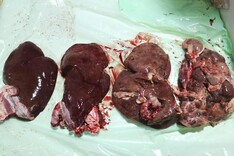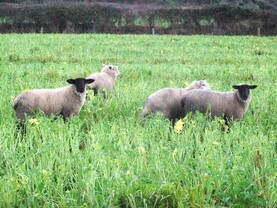The November 2022 liver fluke forecast developed by the Department of Agriculture in collaboration with Met Éireann, UCD, Teagasc and Animal Health Ireland predicts infection being prevalent in the west and northwest, with occasional losses in the midlands, east Munster and north Leinster.
The forecast is based on information on meteorological data gathered between May and October 2022 by Met Éireann, with the Ollerenshaw summer index used to predict the degree of risk.

Figure 1: Ollerenshaw summer index values 2022 and the risk of disease due to liver fluke.
The index values detailed in Figure 1 are said to be lower than previous years and the forecast explains that this is due to drier conditions in June, July and August, especially in the south and east.
“May was dry in the south, whereas it was wet in the northwest, reflecting the higher values, while June was wetter in the west than the rest of the country, resulting in the overall index values being higher in the west and northwest.”
Other information sources
The forecast also utilises other sources of information such as the Beef HealthCheck programme, run in partnership with Meat Industry Ireland.
This collects and reports liver fluke information in cattle at slaughter from participating meat factories nationwide.
“Overall, this year’s levels of liver fluke infection are very similar to those reported in 2021. To date, abattoir examinations showed an average of 44% of herds with at least one animal with liver damage due to liver fluke and live liver fluke parasites were seen in 13% of herds.
"Counties in the northwest of Ireland were more heavily affected, with 70% to 80% of herds in Sligo, Roscommon and Donegal reported to have signs of liver fluke at slaughter.”
The report advises that county level maps of liver fluke infection levels can be found here.
Regional veterinary laboratory
Since 2015, from June to December, the Department of Agriculture has collected blood samples from lambs in meat factories from a proportion of flocks at the time of slaughter.
These have been tested for the presence of liver fluke antibodies to determine the timing and geographical spread of liver fluke exposure in grazing lambs.
The number of flocks selected for sampling from each county is intended to be proportionate to the sheep population of that county over the entire sampling period (July to November 2022). A number of samples are taken from each selected flock and these are pooled at laboratory level.
The presence of liver fluke antibodies in 2022-born lambs is therefore a sentinel for exposure to liver fluke in the wider sheep population in the region, as, by definition, these lambs must have been exposed during the 2022 grazing season.
Blood samples from 354 flocks from July to August 2022 across 26 counties were tested for the presence of liver fluke antibodies. Data from this survey indicates that the majority of infected flocks are from counties on the western seaboard.
Some positive and inconclusive results were found in counties outside of the west and the northwest in the August testing, possibly associated with a high summer rainfall level.
By October, as well as a lot of positive and inconclusive results in counties on the western seaboard, there was substantial evidence of fluke exposure in lambs from the border areas, midlands, south and in Leinster.
Treatment and control
The forecast recommends developing a treatment control programme in conjunction with your vet for high-risk areas.
“When using flukicides to control and treat liver fluke infection, particular attention should be given to dosing cattle at the time of housing or shortly thereafter, and sheep in autumn or earlier in the year, where indicated by faecal examination results or prior disease history.
"For sheep, a drug effective against early immature as well as late immature and mature flukes should be used to protect against acute disease. In addition, sheep should be moved from affected pasture to prevent reinfection”.
For cattle, the report advises caution surrounding housing of animals depending on the product used.
“If the flukicide given to cattle at housing is not effective against early immature fluke, then faecal samples should be taken six to eight weeks after housing and tested for the presence of liver fluke eggs. This will determine whether a follow-up flukicide treatment is necessary.”
For outwintered animals, it is important to monitor livestock and implement a control strategy based on the level of risk anticipated.
The November 2022 liver fluke forecast developed by the Department of Agriculture in collaboration with Met Éireann, UCD, Teagasc and Animal Health Ireland predicts infection being prevalent in the west and northwest, with occasional losses in the midlands, east Munster and north Leinster.
The forecast is based on information on meteorological data gathered between May and October 2022 by Met Éireann, with the Ollerenshaw summer index used to predict the degree of risk.

Figure 1: Ollerenshaw summer index values 2022 and the risk of disease due to liver fluke.
The index values detailed in Figure 1 are said to be lower than previous years and the forecast explains that this is due to drier conditions in June, July and August, especially in the south and east.
“May was dry in the south, whereas it was wet in the northwest, reflecting the higher values, while June was wetter in the west than the rest of the country, resulting in the overall index values being higher in the west and northwest.”
Other information sources
The forecast also utilises other sources of information such as the Beef HealthCheck programme, run in partnership with Meat Industry Ireland.
This collects and reports liver fluke information in cattle at slaughter from participating meat factories nationwide.
“Overall, this year’s levels of liver fluke infection are very similar to those reported in 2021. To date, abattoir examinations showed an average of 44% of herds with at least one animal with liver damage due to liver fluke and live liver fluke parasites were seen in 13% of herds.
"Counties in the northwest of Ireland were more heavily affected, with 70% to 80% of herds in Sligo, Roscommon and Donegal reported to have signs of liver fluke at slaughter.”
The report advises that county level maps of liver fluke infection levels can be found here.
Regional veterinary laboratory
Since 2015, from June to December, the Department of Agriculture has collected blood samples from lambs in meat factories from a proportion of flocks at the time of slaughter.
These have been tested for the presence of liver fluke antibodies to determine the timing and geographical spread of liver fluke exposure in grazing lambs.
The number of flocks selected for sampling from each county is intended to be proportionate to the sheep population of that county over the entire sampling period (July to November 2022). A number of samples are taken from each selected flock and these are pooled at laboratory level.
The presence of liver fluke antibodies in 2022-born lambs is therefore a sentinel for exposure to liver fluke in the wider sheep population in the region, as, by definition, these lambs must have been exposed during the 2022 grazing season.
Blood samples from 354 flocks from July to August 2022 across 26 counties were tested for the presence of liver fluke antibodies. Data from this survey indicates that the majority of infected flocks are from counties on the western seaboard.
Some positive and inconclusive results were found in counties outside of the west and the northwest in the August testing, possibly associated with a high summer rainfall level.
By October, as well as a lot of positive and inconclusive results in counties on the western seaboard, there was substantial evidence of fluke exposure in lambs from the border areas, midlands, south and in Leinster.
Treatment and control
The forecast recommends developing a treatment control programme in conjunction with your vet for high-risk areas.
“When using flukicides to control and treat liver fluke infection, particular attention should be given to dosing cattle at the time of housing or shortly thereafter, and sheep in autumn or earlier in the year, where indicated by faecal examination results or prior disease history.
"For sheep, a drug effective against early immature as well as late immature and mature flukes should be used to protect against acute disease. In addition, sheep should be moved from affected pasture to prevent reinfection”.
For cattle, the report advises caution surrounding housing of animals depending on the product used.
“If the flukicide given to cattle at housing is not effective against early immature fluke, then faecal samples should be taken six to eight weeks after housing and tested for the presence of liver fluke eggs. This will determine whether a follow-up flukicide treatment is necessary.”
For outwintered animals, it is important to monitor livestock and implement a control strategy based on the level of risk anticipated.







 This is a subscriber-only article
This is a subscriber-only article










SHARING OPTIONS: